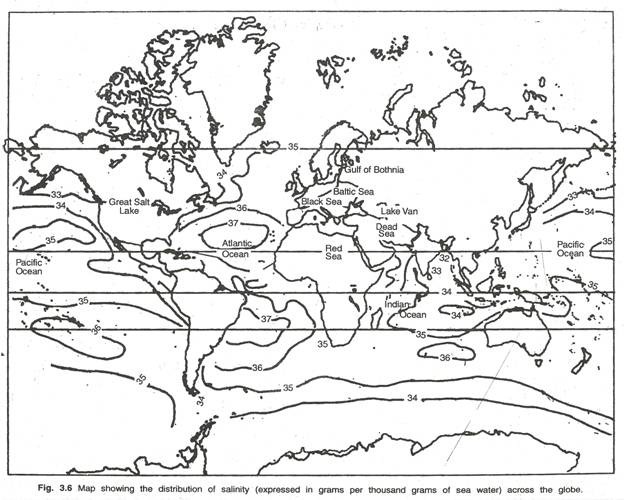salinity of seawater
Simply put, salinity means the amount of dissolved salts-per unit mass of water. Salinity is expressed as the number of grams of dissolved salts in 1,000 grams of sea water.
The average salinity of the sea water is 35 per thousand. It means that in one kilogram of sea water, there are 35 grams of dissolved salts.
Composition of Salts In every cubic kilometre of sea water, there are 41 million tonnes of dissolved salts.
Share of different salts is as shown below:
i. Sodium chloride — 77.7%
ii. Magnesium chloride — 10.9%
iii. Magnesium sulphate — 4.7%
iv. Calcium sulphate — 3.6%
v. Potassium sulphate — 2.5%
These salts are mainly of terrestrial origin.
Role of Salinity:
Salinity determines compressibility, thermal expansion, temperature, density, absorption of insolation, evaporation and humidity. It also influences the composition and movement of the sea water and the distribution of fish and other marine resources.
Distribution of Salinity:
There are two aspects to it—horizontal and vertical distribution. The amount of salinity varies from one part of the ocean to another.
This variation is influenced by the following factors:
(i) Difference between evaporation and precipitation
(ii) Stream run-off
(iii) Freezing and melting of ice
(iv) Atmospheric pressure
(v) Wind direction
(vi) Movement of the sea water.
The areas of highest salinity are found near the tropics, from where the salinity decreases towards the equator and towards the poles (Fig. 3.6). This is because, at the tropics, there is active evaporation owing to clear skies, high temperatures and the steady trade winds. In the Atlantic Ocean, the salinity near the tropics is about 37% (Per thousand). On the other hand, near the equator, there is heavy rainfall, high relative humidity, cloudiness and calm air of the doldrums.
The equatorial region of the Atlantic Ocean has a salinity of about 35. The polar areas experience very little evaporation and receive large amounts of fresh water from the melting of ice. This leads to low levels of salinity, ranging between 20% and 32%. Thus maximum salinity occurs between 20°N and 40°N, and 10°S and 30°S latitudes.
In the open, seas, the variation in salinity level is less” pronounced compared to the partly or wholly enclosed seas. For instance, in the Baltic Sea, salinity increases from 11 % near the south Swedish coast, to 20% near the head of the Gulf of Bothnia. Black Sea receives many rivers, and thus, its salinity is 18% only. The Red Sea, on the other hand, experiences great evaporation and there are no rivers falling into it. Therefore, it has a salinity of 40% or more.
The salinity of the inland seas and lakes is very high because of the regular supply of salt by the rivers falling into them. Their water becomes progressively more saline due to evaporation. For instance, the salinity of the Great Salt Lake (Utah, USA), the Dead Sea and the Lake Van in Turkey is 220%, 240% and 330% respectively. The oceans and salt lakes are becoming more salty as time goes on, because the rivers dump more salt into them, while fresh water is lost due to evaporation.
Sub-Surface Salinity:
With depth, the salinity also varies, but this variation again is subject to latitudinal difference. The decrease is also influenced by cold and warm currents. In high latitudes, salinity increases with depth. In the middle latitudes, it increases upto 35 metres and then decreases. At the equator, surface salinity is lower.


